17 Most Endangered Ducks in the World According To IUCN Red List
There are more than 130 species of ducks found across lakes, rivers, wetlands, and coastlines around the world. Sadly, many of these remarkable waterfowl are facing serious threats to their survival. Pollution, hunting, habitat loss, and climate change have all taken a toll on duck populations, pushing several species dangerously close to extinction.
This is a list of 17 of the most endangered ducks in the world, all currently classified as Endangered or Critically Endangered on the IUCN Red List. Each one represents a unique part of our planet’s biodiversity—and a reminder of why conservation efforts are so vital.
- 1. Pink-headed Duck
- 2. Crested Shelduck
- 3. Madagascar Pochard
- 4. Campbell Teal
- 5. Brown Teal
- 6. Laysan Duck (Laysan Teal)
- 7. Baer’s Pochard
- 8. Meller’s Duck
- 9. Pomeranian Duck
- 10. White-headed Duck
- 11. Brazilian Merganser
- 12. Scaly-sided Merganser
- 13. White-winged Duck
- 14. Spectacled Eider
- 15. Blue Duck (Whio)
- 16. Harlequin Duck
- 17. Blue-billed Duck
1. Pink-headed Duck

The Pink-headed Duck is one of the great mysteries of the bird world. It hasn’t been officially seen in the wild since 1935 in India, and many scientists believe it may already be extinct. However, there are occasional unconfirmed reports from remote swamps and wetlands in Myanmar, giving a small glimmer of hope that a few may still survive. This duck became rare because its marshy home was drained for farming, and it was also hunted for its unusual beauty.
These ducks were known for their pale pink heads and graceful, quiet behavior. They preferred shallow, overgrown wetlands where they could hide among reeds and feed on plants, insects, and small snails. Sadly, because these habitats have almost completely disappeared, the Pink-headed Duck might now exist only in legends and old paintings. But birdwatchers still hope that one day, it might be rediscovered in the wild.
2. Crested Shelduck
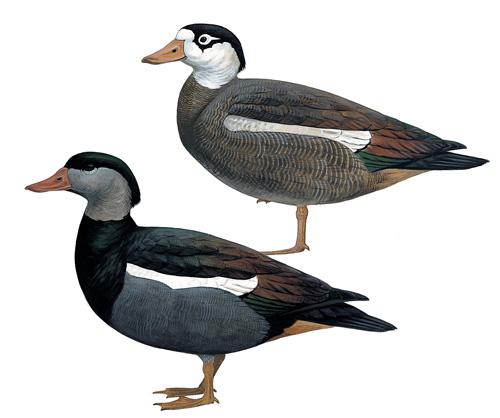
The Crested Shelduck is another duck that might already be gone. It hasn’t been officially seen since 1964, but a few possible sightings from remote parts of China and North Korea keep scientists from declaring it extinct. It is listed as Critically Endangered because if it still survives, its population is extremely tiny and hidden. Loss of wetlands, hunting, and human disturbance are believed to be the main reasons for its decline.
This duck was known for a small feathered crest on its head and a fondness for quiet, high-altitude lakes or coastal marshes. Very little is known about its behavior, but it was thought to migrate short distances and feed on plants, seeds, and small aquatic creatures. Because it is so secretive and lives in places that are hard to reach, some bird lovers still believe it may be out there, quietly surviving far from human eyes.
3. Madagascar Pochard

For a long time, everyone thought the Madagascar Pochard was gone forever. It disappeared from sight and was believed extinct in the late 1990s. But in 2006, a tiny population was rediscovered on a small, hidden lake in northern Madagascar. Today, it is still Critically Endangered, with fewer than 30 left in the wild. Thankfully, conservation groups have helped by raising ducklings in captivity, and now more than 90 exist in total. Some have already been released into a safer lake called Lake Sofia.
These ducks live on freshwater lakes and dive to catch insects, snails, and other small creatures underwater. They prefer quiet, deep water with plenty of vegetation. One of the biggest problems they face is the loss of natural wetlands and the introduction of fish that compete for food or disturb their nests. Saving this duck is difficult, but its rediscovery shows that hope and hard work can bring a species back from the edge.
4. Campbell Teal
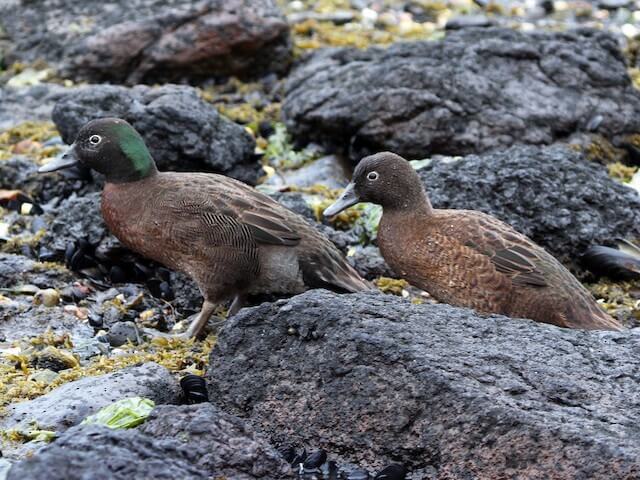
The Campbell Teal is a small, flightless duck from New Zealand, and it has had quite a journey. It was once thought to be extinct on its home, Campbell Island, until a tiny population was found on nearby Dent Island in 1975. Thanks to careful breeding and reintroduction programs, its numbers have improved, and its IUCN status has moved from Critically Endangered to Vulnerable. This is one of conservation’s success stories, but the species is still at risk and needs continued protection.
Since Campbell Teals don’t fly, they spend their lives hiding in thick grass and searching for insects and tiny creatures at night. They prefer wet, tussock-covered coastal areas where predators like rats and cats can’t easily reach them. Their biggest threats were introduced animals, habitat loss, and bad weather. Even though they are safer now, they still rely on predator-free islands and human care to survive.
5. Brown Teal
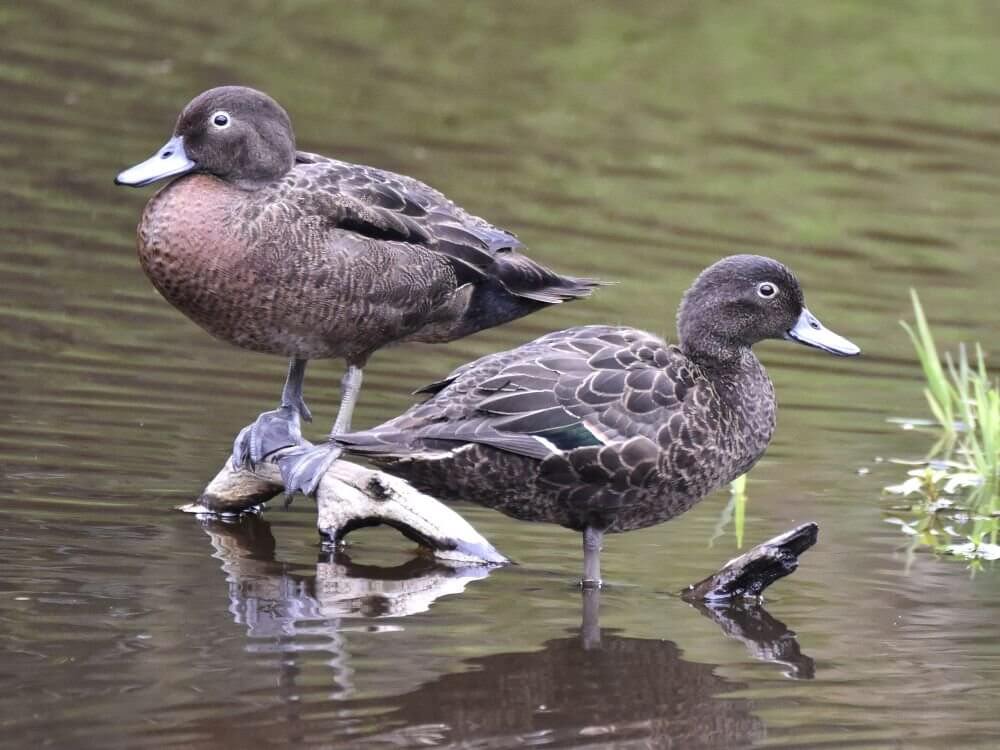
The Brown Teal, also known as the Pāteke, is one of New Zealand’s most threatened native ducks. Once found all over the country, their numbers dropped sharply because of hunting and predators like stoats, rats, and cats. Today, fewer than 1,000 adults remain in the wild, which is why this species is listed as Endangered. Thankfully, conservation work started early—legal protection began in 1921, and ongoing projects now help them live in predator-free areas.
These ducks like calm wetlands, streams, and estuaries where they forage at night for insects, snails, and plants. They are shy and often hide in thick vegetation during the day. Thanks to careful breeding and releases, small but growing populations now live in protected areas—showing how much difference people can make when they decide to help.
6. Laysan Duck (Laysan Teal)
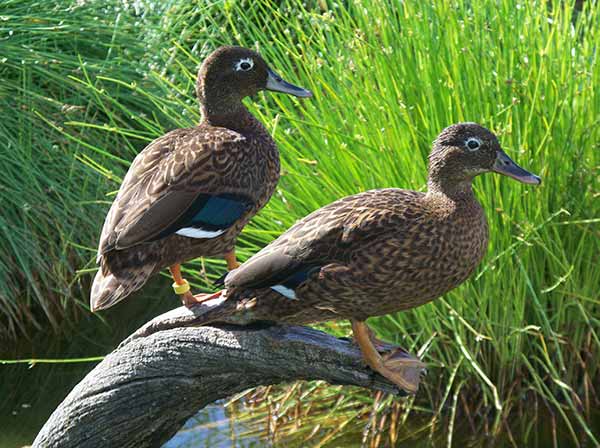
The Laysan Duck is a small, rare duck found only in Hawaii—nowhere else in the world. Long ago, it lived across several Hawaiian Islands, but habitat loss, hunting, and introduced animals nearly wiped them out. At one point, only about 20 ducks survived on Laysan Island. Because of careful protection and the creation of new safe homes on other islands and atolls, the species has slowly recovered and is now listed as Threatened instead of Critically Endangered.
These ducks don’t migrate and prefer shallow ponds and salty wetlands. They feed mostly at night, snapping up tiny insects, brine flies, and their larvae. One of their most charming habits is “fly-snapping,” where they leap into the air to catch insects. Even though their population is still small, they’re a wonderful example of how conservation can bring a species back from the edge.
7. Baer’s Pochard

Baer’s Pochard is one of the most endangered ducks in the world, with fewer than 1,000 mature birds left. It is listed as Critically Endangered, mainly because its wetlands in China, Russia, and Southeast Asia are being drained or polluted. Hunting and the loss of safe wintering sites have also pushed this beautiful diving duck toward extinction. In China, it is now a first-class protected species, which means harming it is illegal.
This pochard prefers deep lakes and marshes where it dives underwater to feed on plants, snails, and aquatic insects. During winter, it migrates south to warmer regions, though fewer safe places remain. Its dark head, white flanks, and strong diving ability make it easy to recognize—if you’re lucky enough to see one. Saving it will depend on restoring wetlands and protecting its migration routes.
8. Meller’s Duck
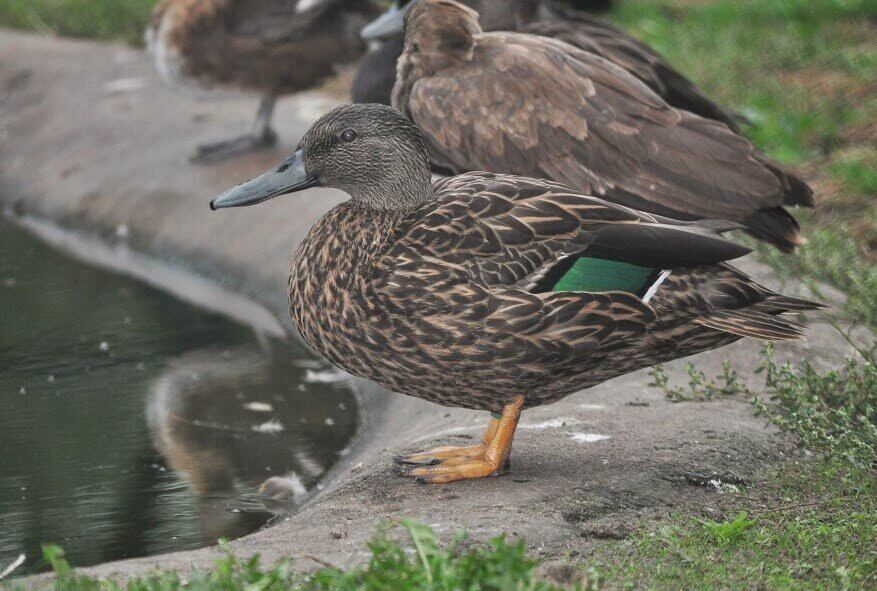
Meller’s Duck is an endangered species found mostly in Madagascar. For many years, people didn’t realize it was a species of its own; it was wrongly thought to be just a type of mallard. Because of this mistake, conservation efforts were delayed. Today, it is listed as Endangered due to habitat loss, especially around Lake Alaotra, where wetlands were drained or taken over for farming and fishing.
Meller’s ducks prefer freshwater lakes and slow-moving rivers, nesting in tall reeds or thick vegetation. They are strong, territorial birds and can be quite aggressive in defending their nesting sites. Unlike many other ducks, they don’t migrate and stay in their home wetlands year-round. Captive breeding programs in Europe are helping a little, but Meller’s Ducks remain rare both in the wild and in captivity—making every remaining bird incredibly valuable.
9. Pomeranian Duck
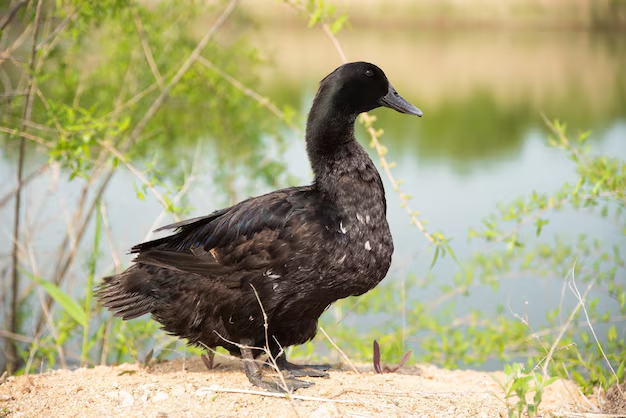
The Pomeranian Duck is a rare domestic breed rather than a wild species, but it is still considered endangered because so few are left. It originated in the Pomerania region of Germany and Poland and nearly disappeared as modern farming replaced traditional duck keeping. Today, only a small number survive, mostly cared for by breeders, hobby farmers, and conservation groups in Germany and Switzerland.
This duck is known for its calm nature and attractive plumage, often in shades of black, blue, or lavender with a white chest. It is a hardy breed that does well on small farms and loves grazing near ponds or meadows.
10. White-headed Duck
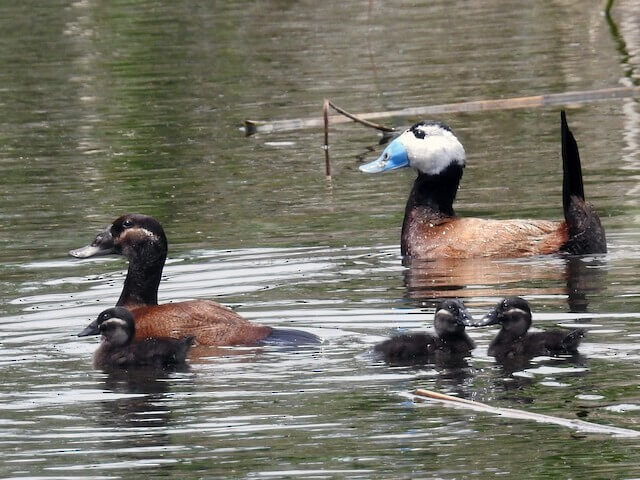
The White-headed Duck is an Endangered species found mainly in Spain, North Africa, and parts of Central Asia. Its numbers are declining because their wetlands are being drained or polluted, and hunting has taken a toll. Another major threat is hybridization—this duck sometimes breeds with the introduced Ruddy Duck, and their mixed offspring make it harder to keep the species pure.
These ducks are diving birds and prefer quiet lakes with deep water and thick reeds. Males are easy to spot with their bright white heads and blue bills during breeding season. They feed mostly on underwater plants, insects, and snails. Conservationists are currently working hard to protect wetlands and control Ruddy Ducks to give this species a better chance of survival.
11. Brazilian Merganser

The Brazilian Merganser is one of the rarest ducks in the world and is listed as Critically Endangered. It lives in clear, fast-flowing rivers in Brazil, Argentina, and Paraguay, but these habitats are disappearing because of deforestation, mining, dams, pollution, and even canoeing and tourism. Fewer than 250 individuals are thought to survive in the wild.
They nests in tree hollows or rock crevices near riverbanks and is very shy and difficult to spot. It has a slender body and long bill, perfect for catching fish. Conservation groups are breeding them in captivity to help save the species. In 2011, the Itatiba Zooparque in Brazil successfully hatched the first chicks in captivity, and zoos like Prague Zoo joined the effort in 2023, welcoming their first ducklings in 2025.
12. Scaly-sided Merganser

The Scaly-sided Merganser is an Endangered species that lives along forested rivers in the Russian Far East, northeastern China, and parts of North Korea and Japan during winter. It gets its name from the scaly pattern on its flanks. They prefer clean, fast-moving rivers surrounded by quiet forests to nest. They lay eggs in tree cavities, often far from human activity. Sadly, logging, river development, disturbance, and pollution are destroying their homes. Hunting also adds to their decline. Because they rely on such specific habitats, even small changes to their river environments can have a big impact.
13. White-winged Duck
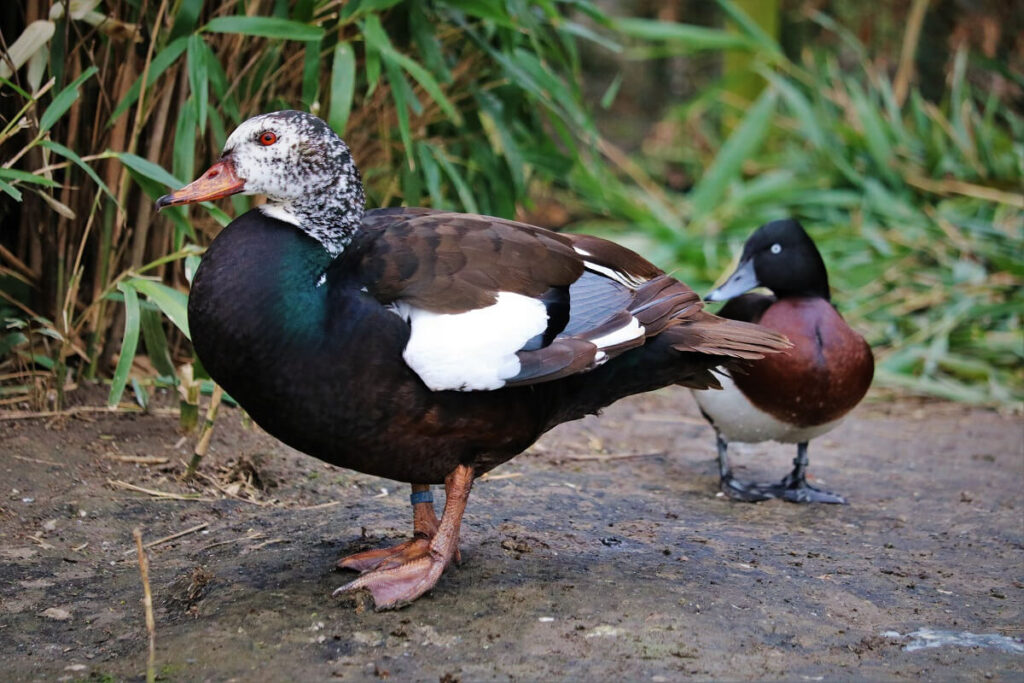
The White-winged Duck is a large and shy forest duck found in parts of India, Southeast Asia, and Indonesia. It is listed as Endangered and protected under CITES Appendix I. Fewer than 450 mature birds remain in the wild, and the number is dropping due to habitat loss, hunting, and human disturbance.
White-winged ducks prefer deep forest wetlands, swamps, and slow-moving rivers. They spend most of their time hidden under dense tree cover and fly mainly at dawn or dusk. Their distinctive white wing patches are usually seen only in flight. Because they need quiet, undisturbed forests to survive, logging and land clearing are some of their biggest threats.
14. Spectacled Eider

The Spectacled Eider may not be globally endangered, but it is still considered Threatened in the United States under the Endangered Species Act. Its population in Alaska dropped sharply in the 1990s, possibly due to climate change, hunting, or changes in sea ice and food availability. In Russia, its numbers are more stable. It is now fully protected from hunting in the U.S.
These sea ducks are named for the white “goggle-like” markings around their eyes. They breed in Arctic tundra wetlands and spend winters floating on icy seas, often in large flocks gathered in small openings in sea ice. They dive to catch clams, crustaceans, and other marine food from the ocean floor. Conservationists continue to monitor their numbers closely to ensure they don’t decline again.
15. Blue Duck (Whio)
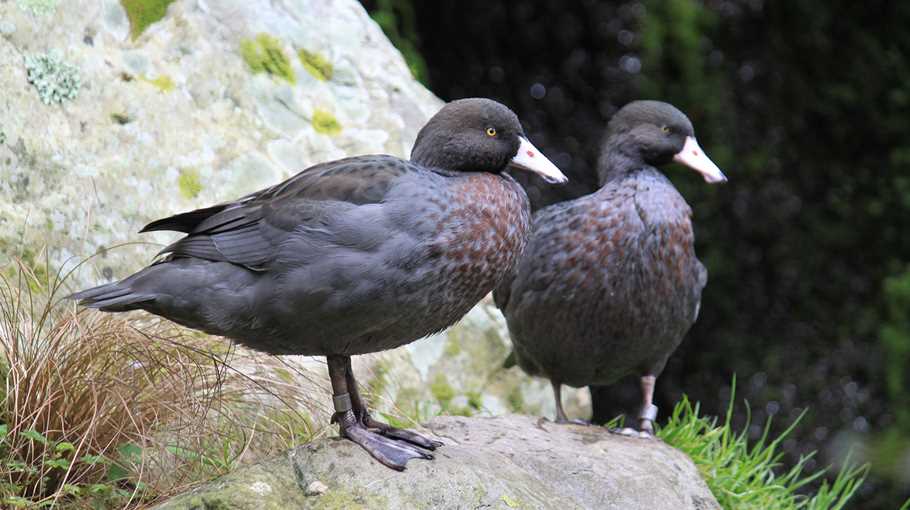
The Blue Duck, or Whio, is one of New Zealand’s most unique river ducks and is listed as Endangered by the IUCN. Fewer than 3,000 remain in the wild, living in small and isolated groups along fast-flowing rivers on both the North and South Islands. Their numbers have fallen due to predators like stoats and ferrets, river damming, and even competition from introduced trout that eat the same stream insects the whio relies on.
Whios are specially adapted for life in rushing mountain streams. Their soft whistling call—“whio”—is how they got their Māori name. They don’t migrate and instead stay close to the same stretch of river year-round. Conservation programs like the Whio Forever Project are helping by trapping predators and raising ducklings in captivity for release back into the wild.
16. Harlequin Duck
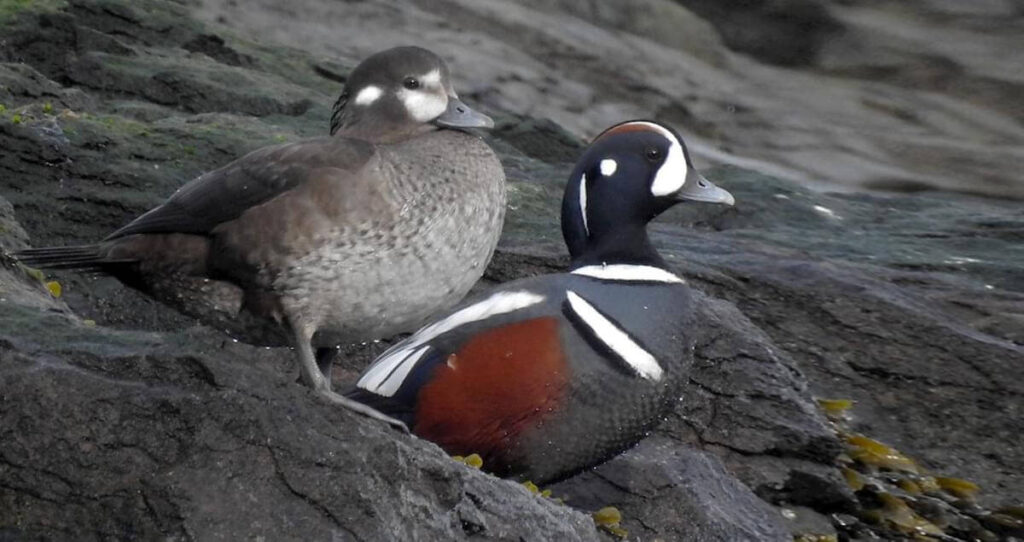
What most people think of first when the Harlequin Duck is mentioned is the male’s stunning appearance. The male has bright, eye-catching feathers with dark blue, chestnut, and white colors that look like they were painted on. While this species is stable in western North America, Europe, and Asia, the eastern North American population is declining and is listed as endangered in places like Canada and Maine. Oil spills, river pollution, and hydroelectric dams that change fast-flowing streams have all harmed their breeding grounds.
Generally, Harlequins love rough waters. They breed along cold, fast mountain rivers and spend winters along rocky coastlines where waves crash against the shore. They dive and swim underwater to catch insects, fish eggs, and small crustaceans. Their love of wild, turbulent water makes them a favorite among birdwatchers—and also makes protecting their habitat especially important.
17. Blue-billed Duck
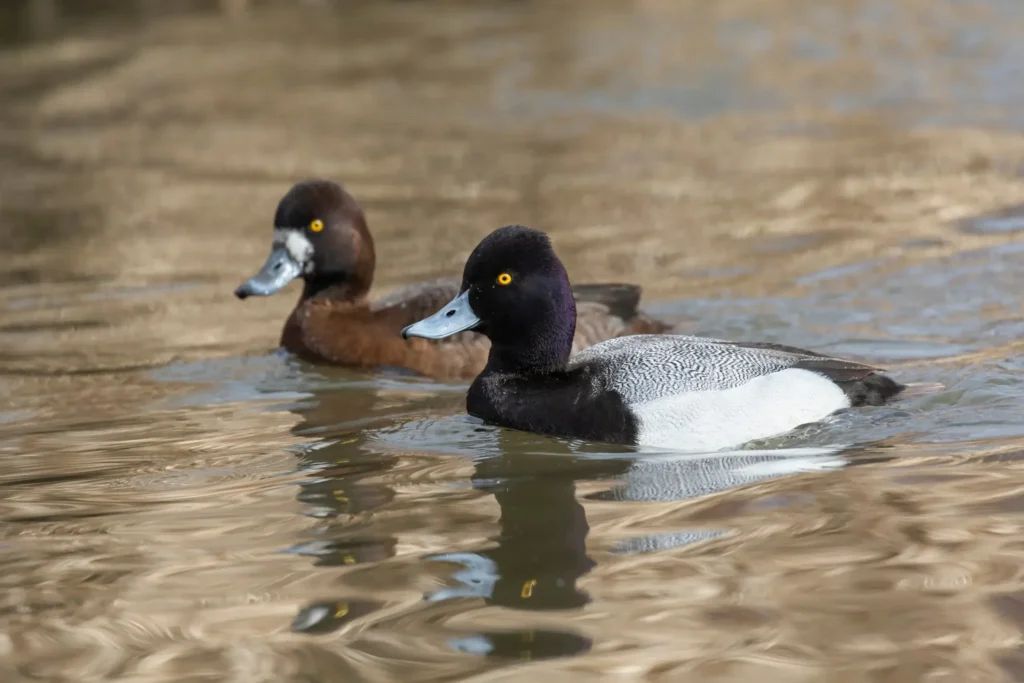
The last duck in our list is this the Blue-billed Duck, a small, stiff-tailed duck found only in Australia. It is listed globally as Least Concern, but in some Australian states it’s considered vulnerable or endangered because many of its wetlands have been drained or damaged by drought and water extraction.
Males are easiest to spot in breeding season when their bills turn a bright powder blue. These ducks prefer deep, permanent freshwater lakes with lots of reeds and vegetation to hide in. They are mostly shy and secretive, spending much of their time diving for seeds, aquatic insects, and small snails. While the species is not in immediate danger globally, caring for Australia’s wetlands is vital to ensure it remains safe in the long term.
